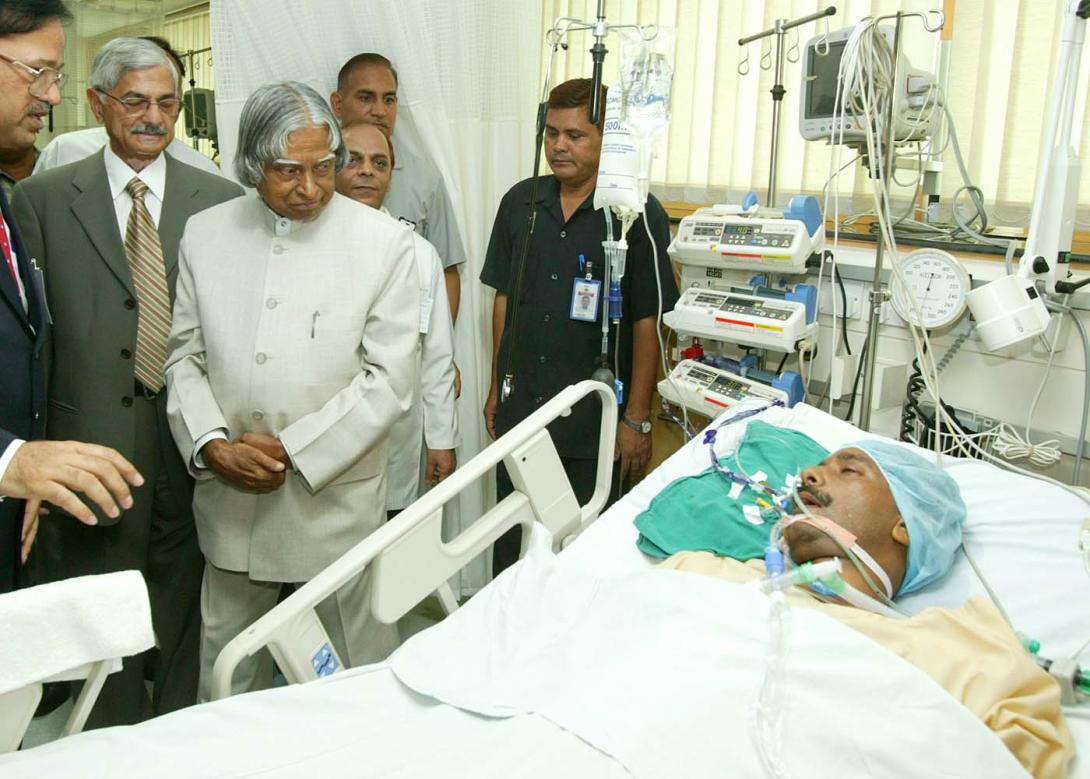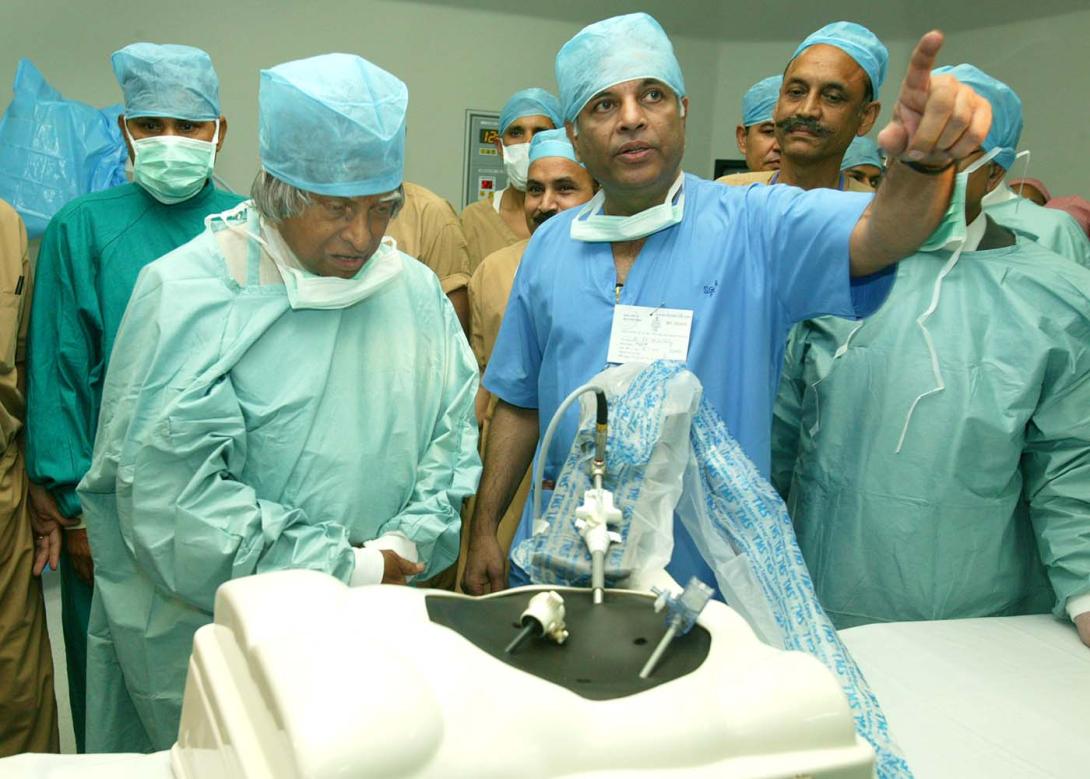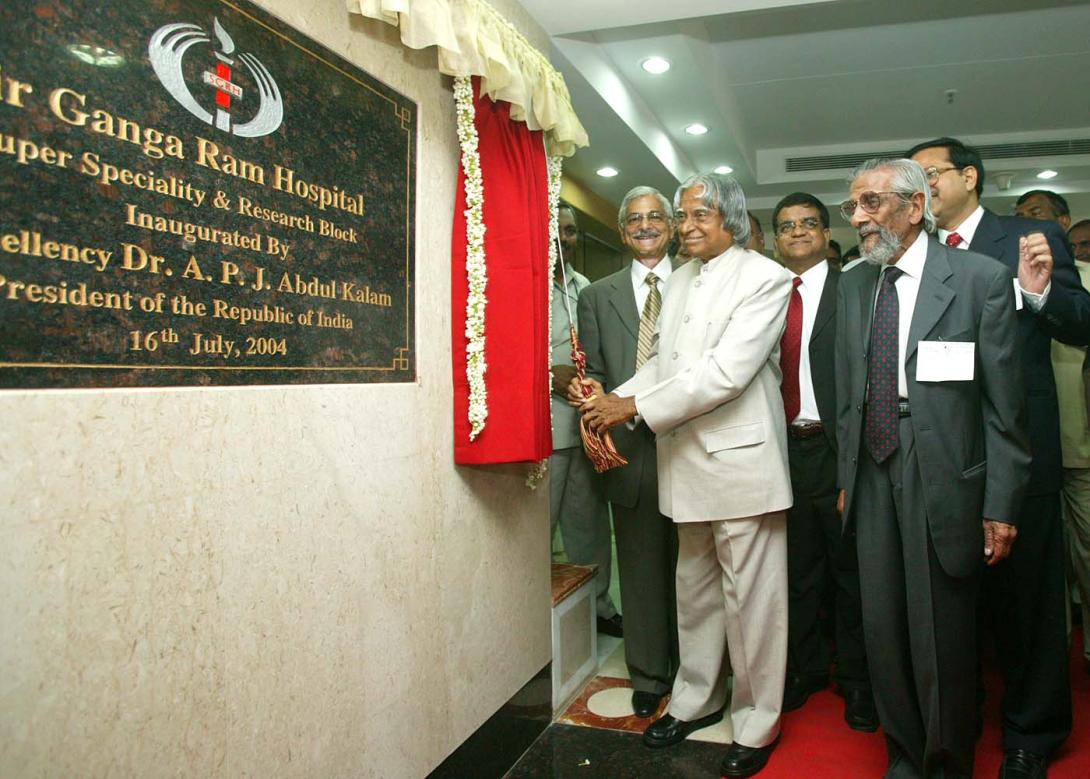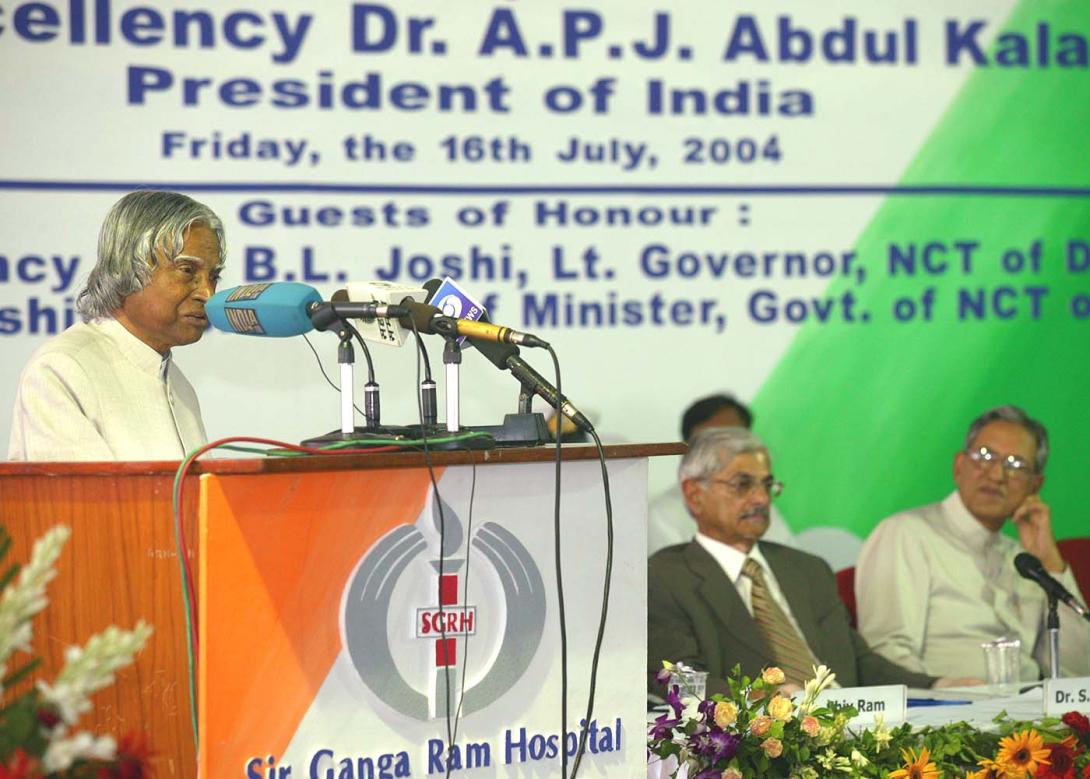Address At The Inauguration Of The Super Speciality And Research Block Of Sir Ganga Ram Hospital, New Delhi
New Delhi : 16-07-2004
The Mission Of Healthcare;
I am indeed delighted to participate in the inauguration of the Super Speciality and Research Block of Sir Ganga Ram Hospital in its Golden Jubilee Year. When I am with you I am reminded of two incidents connected with Sir Ganga Ram Hospital. The first incident dates back to 1998 when I was invited by Shri Dharma Viraji, a Padma Vibhushan awardee, and the architect of this hospital, to deliver the second Sir Ganga Ram Oration in that year. I salute late Dharma Viraji for his extra-ordinary contribution for evolving, establishing and bringing this hospital into a world class medicare centre: apart from his sterling contribution in the national affairs. The second incident arose due to a letter received by me in June 2004 stating that Shri Ramachandra Veerapa, a 96 years old Honourable Member of Lok Sabha, is ailing in Sir Ganga Ram hospital and desired to meet me. He is a member of the 14th Lok Sabha and has been elected to the house continuously for 8 times. I visited and met Shri Ramachandra Veerapa at the hospital on 12 June 2004 and wished him fast recovery. I was impressed by the healthcare provided to the ailing MP by the specialist Doctors and the nursing staff of this Hospital. I can see the vision of the pioneers of the Sir Ganga Ram hospital resulting into healthcare with a humane heart. When you give quality healthcare with smile to those who cannot afford the cost you are indeed the blessed. I congratulate the Board of Trustees for establishing the Super Speciality and Research Block.
When I see the Doctors I see them as pain removers. In a hospital when no doctors, no relatives are around the patients during night time, in the wards what you hear is pain and pain. That is the time the nurses go around to provide consolation and relief to the patients. At that time nurses appears to be angels for the patients to cater to their requirements like medicines, dressing and other daily needs. All of you provide yeoman service in removing human miseries and pain with human intelligence and patience. ?Service to human being is service to God?. I greet the management, doctors, paramedical and support staff for their contribution in providing the state-of-the-art Medicare to the needy patients. I was thinking what I should talk to this audience. I would like to share my views on the mission of India?s healthcare.
Quality hospitals in the rural areas
The Union Finance Minister during his Budget Speech on 8th July 2004 has extended the benefit of Section 80-1B to new hospitals with 100 beds or more set up in rural areas. Such hospitals will be entitled to a 100 per cent deduction of their profits for a period of five years.? This provision with the future vision for newer hospitals by institutions like Sir Ganga Ram hospital can consider establishing hospitals in certain rural sectors, especially in the states like Bihar, Orissa and Eastern UP. These rural hospitals can be established in such a way that quality healthcare can be assured for all in the country.
Telemedicine
These rural hospitals can be linked through tele-medicine models to hospitals in urban areas. One of the institutions Narayana Hrudayalaya has connected 19 remote areas with Kolkatta and Bangalore. They have treated 12,000 patients through telemedicine. The partners in this mission are Private sector hospital and government hospitals. CARE Hospitals Hyderabad has a tele-medicine link between Hyderabad, Mehaboobnagar, Agartala and Delhi. Similarly, Indian Space Research Organisation (ISRO) has connected some leading hospitals to their health centres. These models can be replicated in different areas in the country to provide affordable, quality Medicare to our rural masses who will have the benefit of attention from the renowned specialists of Sir Ganga Ram Hospital.
Medical Insurance
In addition to the above to make medicare affordable, a Medical Insurance Scheme which is in vogue in some parts of the country can be implemented by Sir Ganga Ram Hospital. In Karnataka, the state co-operative department in collaboration with Narayana Hrudayalaya has come out with a scheme called Yeshasvini. In this scheme, the villagers are required to pay a premium of Rs. 5 per month. The government contribution is Rs. 2.50 per month. There are 17 lakh members in this scheme; the members are eligible to get free treatment from the best available Medicare facility in the state in 85 recognized hospitals. Presently in this scheme they have provided free medical consultation to 27,000 people and carried out 7000 operations including 600 open-heart operations in 7 months period. This model or an improved version can be considered by Sir Ganga Ram Hospital for many states for providing quality health care to the village community at an affordable cost.
Holistic Treatment
In India we are having a variety of traditional systems of medicines such as Yoga and Naturopathy, Ayurveda, Unani, Homeopathy and Siddha. These ancient systems of medicines are unique to our country and many times they are complimentary to each other. This system needs scientific method of testing with clinical data. I would consider appropriate to create these wings in the hospital so that patients can have a choice in determining the system of medicine, which they would like to have. This will enable rapid development of medicines and fast track clearance of products through integrated clinical trials and approval from ethical committee. This area will be a great wealth generator for the nation.
Life style intervention for heart care
I would like to recall an experience during my work as Scientific Adviser to Raksha Mantri. The life style change pattern can be a great influencer in reducing the occurrence of cardiac problem among the Indian population. I recall there was a joint project of Defence Institute of Physiology and Allied Sciences (DIPAS), DRDO and the Global Hospital Research Centre governed by the Brahma Kumaris for studying the effect of "holistic lifestyle intervention" on the patients suffering from Coronary Artery Diseases after angioplasty and surgical intervention. The project involved both Control Group and the Experimental Group. The Control Group was subjected to conventional treatment whereas the Experimental Group was supported by an intervention involving low fat, high fiber vegetarian diet, walking and aerobic exercises and systematic meditation. This psycho-physiological mind-body approach in treating heart patients of the Experimental Group resulted in dissolution of angiographic plaque and improvement in microcirculation of blood in heart components of the patients. The treatment was also supported by participation of spouses and other family members of the patients, leading to a unique family system approach to Medicare.
When I conducted the first review of the project, I found that nearly 60 people had reported positively about their well-being and their clinical reports showed remarkable improvement. When I visited the hospital again after two years, nearly 400 patients gave us a joyful presentation about their experiences. It was an experience of great happiness to see the patients presenting their X-ray records and angiogram, showing us how this unique way of treatment has given great relief to their hearts. The conflict between cardiology, psychology and theology still persists, but this experiment has given a new thrust and a lasting cure for heart patients. The message I would like to convey is that through the integration of medical science, physiology, health care, psychology and spirituality, a native Indian knowledge system in combination with allopathic systems can emerge. Sir Ganga Ram Hospital research team can study this model, improve them and apply them in their hospitals.
Research Areas
Recently I met Prof. Vijay K Varadan of Pennsylvania State University, US. He shared his experience on the possible line of treatment for Parkinson?s disease and Epilepsy. The primary symptoms in Parkinson Disease as you all aware are tremor or trembling in hands, arms, legs, jaw, and face, rigidity or stiffness of the limbs, slowness of movement and impaired balance. Prof Varadan has devised a wireless system for monitoring and control of Parkinson?s disease. The system consists of an implantable DNA insert in the head region for generating a pulse to the nerve system; controlled either by a modified pacemaker or smart hat. A Passive polymer based gyro sensors, which are implanted in the tremor location. The sensor gets the power from the Pacemaker and the Pacemaker then reads the tremor motion. The Pacemaker then generates the pulse in the implanted device in the head to control the tremor. This appears to be a promising line of treatment for such diseases. Prof. Varadan also has reported that the few patients affected by Parkinson diseases had a full recovery. I would recommend Ganga Ram Hospital team to work in such frontier areas of research.
Stem cell therapy for future heart ailments
Newer knowledge emerging out of research on stem cells from abroad and India has to be taken note of and studied. Drawing of tens of thousands of stem cell - immature cells that are capable of transforming themselves into almost any kind of tissues from the suffering patients and inject them into the heart to stimulate heart repair. In one case, it is reported that the pumping efficiency has increased from 25% to 40% over a period of four months. In 2003, successful stem cell procedures that resulted in measurable boost in blood pumping capacity have increased substantially in many countries across the globe. This holds a big promise for effective heart repair for ailing people.
Stem cell research
During my visit to various laboratories in India, I happened to see the beginning of stem cell research for different purposes including brain research. I would like to share with you an important stem cell research application in the field of cardiology. When I met Dr.P. Venugopal, Director, All India Institute of Medical Sciences (AIIMS) a famous cardiovascular and thoracic surgeon, he told me about his experiences. He said in one of the cardiac diseases, where conventional medical and surgical treatment were ineffective because of the affliction of the heart muscle, use of autologous bone marrow stem cells implantation into the diseased heart muscles had been applied in order to improve the function of heart muscle. This kind of application of this procedure is the latest and very few cases have been done in the world, the first time in India. This is expected to open new frontiers in the treatment of patients for regeneration of heart muscles, thereby giving new hope for the patients suffering from end stage heart disease. I suggest the Sir Gangaram Hospital may participate in such a great mission of research.
Conclusion
We need good hearts to treat the ailing patients, we need helping hands to remove the pain, and we need beautiful minds to give happiness to the patients. In this context, I would like to recall and share the essence of a poem. When God first created the human being, it took million and millions of years to get the right human form. He went on experimenting and finally he realized the human configuration he wanted. Once realized, He gave life. First the man opened his eyes and said, ?I thank you, Almighty. Second thing he did, he smiled. Almighty was very happy, that his creation has done two right things. Then, God was preoccupied for some time, later when God looked at the man and found something is missing in him. He generated the fire in milli-seconds and created Shaitan (devil) out of the fire. He asked Shaitan to prostrate before the first human being as he is His image. The Shaitan refused to prostrate. He said, ?Oh! Almighty you have created me out of fire, I am a superior creation?. The God was taken back. He thought for a while and decided to integrate the man and Shaitan into a one single system, that are the human beings what we are. If we want to become close to Almighty God, let our mind and hand be kind to human beings who are suffering particularly with disease. That means we have defeated the Shaitan within us. The question is who will defeat whom? May God bless you to be close to God?s image. Your kindness will flow through your actions, thousands and thousands of patients will be relieved of the pain and they will say ?Thank you doctor? with the smile. That means you are in God?s image.
I am happy to inaugurate the Super Speciality and Research Block of Sir Ganga Ram Hospital.
My best wishes to all members of Sir Ganga Ram Hospital community for success in their missions.
May God Bless You.




